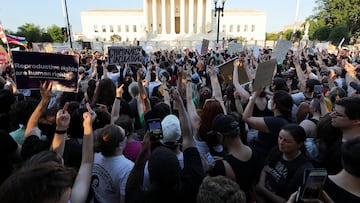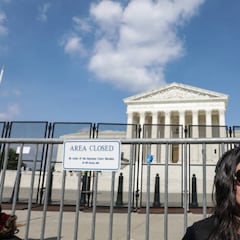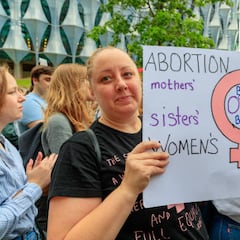Could the Supreme Court overturn Obergefell and end marriage equality?
After the US Supreme Court overturned Roe v. Wade, eliminating a consitutional right to abortion, many wonder what other rights may be at risk.


This week the United States Supreme Court weakened the decision in Miranda v. Arizona by ruling that people do not have the right to sue the police if their Miranda rights are violated, overturned a one hundred and ten-year-old gun law in New York, and overturned the landmark decision in Roe v. Wade that granted the right to abortion.
These actions have left many wondering if other rights that have not been codified under federal law could be overturned and eliminated. These decisions include Obergefell v. Hodges which legalized gay marriage, Lawrence v. Texas which protected the privacy rights of same-sex couples, and Griswold v. Connecticut which protected the rights of married people to purchase contraceptives.
The Dobbs decision comes with a stark warning for gay rights during the last week of Pride Month.
What evidence did the majority use to overturn Roe?
There are two hotly contested legal theories that were used to overturn the landmark case.
The first was that is based on the historical record. The majority stated that the “the right to abortion is not deeply rooted in the Nation’s history and tradition.” The second is based on a legal theory that debates the ability of the Fourteenth Amendment’s Due Process Clause to provide substantive rights. The debate over the Due Process Clause relates to how the justices interpret “liberty.” Both of these theories were used by Justices Thomas and Alito in their dissenting opinions in Obergefell v. Hodges.
Additionally, when opening his opinion, Justice Alito said that “for the first 185 years after the adoption of the Constitution, each State was permitted to address this issue in accordance with the views of its citizens.” Today, there is not a single state where the overturn of Roe v. Wade holds more than thirty-percent support and only around ten to fifteen percent of people believe abortion should always be illegal.
Around sixty-seven percent of people in the US believe that abortion should be allowed within the first trimester. Currently more than ninety-percent of abortions take place during the first twelve weeks of pregnancy. Additionally, those that occur in the second and third trimester are often due to medical issues that impact either the life of the mother or the health of the fetus.
What does the decision in Dobbs say about Obergefell?
Writing for the majority, Justice Samuel Alito said that comparisons between Roe and Obergafell, and the other landmark cases mentioned above, are “designed to stoke unfounded fear that our decision will imperil those other rights.” Since these other cases do not raise questions about “potential life” in the same way Roe v. Wade or Casey v. Planned Parenthood do.
The exercise of the rights at issue in Griswold, Eisenstadt, Lawrence, and Obergefell does not destroy a “potential life,” but an abortion has that effect”
Samuel Alito, US Justice of the Supreme Court
Later in the opinion, Justice Alito clarified and emphasized that this decision does not concern the same “constitutional right” as the other cases and that “nothing in this opinion should be understood to cast doubt on precedents that do not concern abortion.”
This is no comfort to many when Justices Kennedy, Alito, and Thomas all wrote dissenting opinions in Obergefell when that decision was decided.
At the very end of the majority’s opinion, they write that these “cases are distinguishable,” but that “each precedent is subject to its own stare decisis analysis, and the factors that our doctrine instructs us to consider like reliance and workability are different for these cases than for our abortion jurisprudence.” While the majority opinion makes it clear that the cases are different and based on different legal theories it provides no evidence that differing constitutional originalist or textualist approaches could not be applied to overturn the precedent set in these other cases.
Justice Alito, Thomas, and Roberts all decented in Obergefell
In 2015, when the court ruled that marriage equality was protected under the Due Process Clause of the Fourteenth Amendment, justices Justice Alito, Thomas, and Roberts all rejected the decision.
The main argument used throughout these opinions is the question of whether or not marriage equality should be legal on the federal level and whether the court had the constitutional authority to grant the new right.
A warning in the concurring opinion of Clarance Thomas
In his decent in Obergefell, Justice Thomas wrote that the “decision [...] is at odds not only with the Constitution but with the principles upon which our Nation was built. Since well before 1787, liberty has been understood as freedom from government action, not entitlement to government benefits.” The Justice warned that the legal precedent in the case created a danger that judges could “‘roa[m] at large in the constitutional field’ guided only by their personal views” as to the “‘fundamental rights’” protected by that document.”
Similar argumentation to that used to defend the overturning of Roe was used in Thomas’ decent when he said that the Due Process Clause does not “secure any substantive rights” and that applies to abortion. Thomas writes that “in future cases, we should reconsider all of this Court’s substantive due process precedents, including Griswold, Lawrence, and Obergefell” and that the Court has “a duty to “correct the error” established in those precedents.”
What risks does this ruling pose according to Justices Breyer, Sotomayor, and Kagan?
The dissenting opinion struck at the heart of the idiosyncrasies riddled throughout the majority’s opinion. While various justices in the majority say that other substantive rights granted under the Due Process Clause of the Fourteen Amendment are not at risk, the dissenters disagree.
The majority relies on an originalist interpretation of the constitution which grounds that overturn of Roe in the fact that “right to elect an abortion is not “deeply rooted in history” and that “not until Roe, the majority argues, did people think abortion fell within the Constitution’s guarantee of liberty.”
“The same could be said, though, of most of the rights the majority claims it is not tampering with.”
Related stories
The majority made the claim that the reason Roe was different was because it involved potential life, but the concurring opinion of Justice Thomas highlighted that the overturn was justified because Roe created a substantive right. Obergefell also created a substantive right to marriage equality, and the three dissenters worry that this decision gives the Court free reign to overturn “all rights that have no history stretching back to the mid- 19th century.”
Either the mass of the majority’s opinion is hypocrisy, or additional constitutional rights are under threat. It is one or the other.
Justices Breyer, Kagan, and Sotomayor
What concerns the three justices is that the decision to overturn Roe demonstates a belief by the majority that nothing “of constitutional significance attached to a woman’s control of her body and the path of her life.” If a Court is willing to dismiss such fundemental human rights, others have no weight in the minds of the majority.

